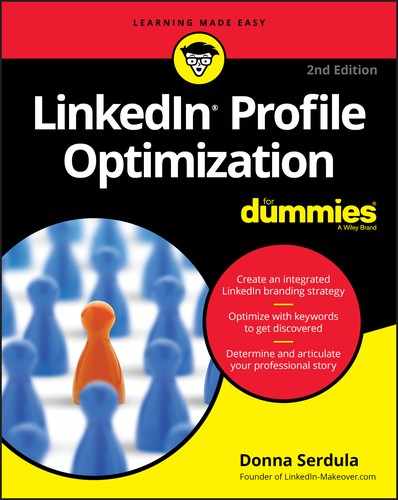Chapter 14
Following Groups, Companies, and Influencers
IN THIS CHAPTER
![]() Handpicking the groups on your profile
Handpicking the groups on your profile
![]() Following the right Influencers and news topics
Following the right Influencers and news topics
![]() Showing allegiance to companies and schools
Showing allegiance to companies and schools
Your LinkedIn activity is reflected on your profile. The LinkedIn Groups you join and the Influencers and news topics you follow all show up at the bottom of your LinkedIn profile. Rather than ignore this area, build up your brand and online persona by following the right groups, Influencers, news topics, companies, and schools to align with your LinkedIn goals.
In this chapter, you learn the importance of joining LinkedIn Groups (and it’s not just for the discussion value) and how to choose the best groups. I also show you how to optimize the Following section by choosing the right Influencers, news topics, companies, and schools to complete the construction of your profile to your desired brand vision.
Understanding the Importance of Groups
The groups you join on LinkedIn are listed toward the bottom of your profile in the Interests section. By clicking See All, and selecting the Groups tab, the group logos appear, showing your reader your online involvement in your industry and community (see Figure 14-1).
LinkedIn Groups are forums devoted to discussions around a single topic. When reading your LinkedIn newsfeed, you see status updates with discussions, quotes, and links to articles about a myriad of topics. With such a wide range of topics taking place, some people find it overwhelming. On the flip side, when you visit a LinkedIn Group, the discussions are focused on the group topic, ensuring your interest in the discussions taking place.

FIGURE 14-1: The LinkedIn Groups you belong to appear near the bottom of your profile.
When you join the groups that interest you, and you engage successfully, LinkedIn Groups provide you the ability to forge new business relationships with like-minded professionals. Within the group, you can post news, participate in discussions, and network. It is a great way to add value and learn from others.
The only issue when it comes to LinkedIn Groups is your own time limitation. There are a slew of LinkedIn experts and professionals who claim to use LinkedIn Groups to find amazing business opportunity. There is certainly business to be mined, but it takes time and energy that not all of us have in abundance. If you have the time and enjoy interacting in group discussions, do it and reap the rewards. On the other hand, if you are a busy person and do not have the time nor inclination to engage in group discussions, I have another way for you to take advantage of LinkedIn Groups in a passive way that provides real results.
It is not a well-known fact, but LinkedIn Groups expand your LinkedIn network. Your LinkedIn network is comprised of connections within three degrees. The people you are directly connected to by exchanging and accepting a LinkedIn invite are considered your first-degree connections. The people directly connected to your first-degree connections are considered your second-degree connections. The connections of your second-degree connections are considered your third-degree connections. Your LinkedIn network is also comprised of the members of groups you have joined.
When you perform keyword-based searches on LinkedIn, you are only searching your LinkedIn network. In order to find people and get found, you need to have an extensive network. The fastest and easiest way to expand your network is through joining LinkedIn Groups. People in the same LinkedIn Groups as you are considered part of your LinkedIn network even if they aren’t first-, second-, or third-degree connections.
Simply by joining groups, you receive the massive benefit of expanding your LinkedIn network. When you have a strong, large network, you get more views to your profile and collide with more opportunities. You do not have to participate in every single group you join. The only thing you need to ensure is that you join groups that contain your target audience.
Determining the types of groups to join
The LinkedIn Groups you join should contain your target audience — not your competitors. Most people join only groups that reflect their interests and careers. As an example, let’s say you are an insurance broker. You may find yourself tempted to join only groups for insurance brokers. When you do that, you are filling your LinkedIn network with your competitors. You don’t want to find or be found only by insurance brokers. Instead, think in terms of your target audience. You want to find and be found by prospective customers. Your prospective customers probably belong to LinkedIn Groups for business owners and human resource professionals. Figure out what LinkedIn Groups attract your target audience and join those groups.
Those who are using LinkedIn for executive branding and thought leadership should join groups that contain their target audience. Do you want to be found by reporters and journalists? Join groups for media professionals. Do you want to be asked to speak at conferences? Join groups that cater to conference and event planners. Do you want to be asked for radio interviews? Join groups for radio broadcasters and podcasters.
One of the easiest ways to determine which groups attract your target audience is to visit the profiles of your current customers or target audience members. Scroll to the bottom of their profiles and look at the groups they have listed on the bottom of their LinkedIn profile. After viewing a number of their profiles, you may start to see certain groups repeated across their profiles. Those are the groups you should join.
The other thing to consider when joining LinkedIn Groups is the number of members within the group. Your network grows by the number of people in the group, so choose LinkedIn Groups with the most members. The bigger your network, the more people you find and the more people who find you.
In addition to the groups that fill your network with your target audience, consider joining groups that demonstrate your expertise and industry knowledge. These groups may contain more of your competition than target audience, but that’s okay as long as you don’t join too many of them.
Another type of groups to join are the groups I like to call “Glory Days.” Your university alumni group falls into this category as well as any groups devoted to old companies at which you worked in the past. By joining these groups where old colleagues, schoolmates, and friends are, you are making sure that if you are not directly connected to them yet, they are still in your network. You never know when one of these old relationships may need your new expertise.
Lastly, join a couple groups that are strictly fun. Do you love martial arts? There are a number of great groups devoted to discussions on martial arts. Do you enjoy technology or history or professional development? There are groups related to all of those topics. It’s important to have fun on LinkedIn, and it’s okay to delve into things you enjoy even if they aren’t pertinent to your career. LinkedIn is all about networking, and networking with people who share common interests is a great way to forge real relationships.
Check out Figure 14-2 to see the ideal breakdown of groups you should join on LinkedIn.

FIGURE 14-2: A breakdown of the LinkedIn Groups you should join.
If you are so inclined to participate in LinkedIn Groups, choose two or three LinkedIn Groups for your focus. Get into the habit of checking out the group discussions once a week. Participate as you can. Add discussions and comment on already occurring discussions. And guess what? If you simply don’t have enough time to keep up with a few groups, don’t worry about it. You can still find amazing benefit from LinkedIn Groups without any true participation.
Turning off group notifications
I am sure you have heard the horror stories about that poor person who decided to join LinkedIn to see what all the buzz was about, and within seconds had sent everyone in his address book invitations to connect or join, right before bombarding the entire network with notifications that he was updating his profile and joining groups dedicated to job search.
What a nightmare! But things have changed in the LinkedIn world. I can’t stress this enough: LinkedIn has changed! It no longer sends out unending notifications to your entire network that you joined a group or updated a project in the Accomplishments section or blinked your eyes.
At one time, I warned people to turn off group notifications, but now this is not something to worry about. You don’t need to turn off group notifications like you once did because LinkedIn doesn’t send out notifications when you join a group.
If you truly want to turn off all notifications, here’s how to do it:
- Go to
LinkedIn.com. Hover your mouse pointer over the thumbnail image of yourself in the upper-right corner of your screen and click Settings & Privacy.
LinkedIn's settings page opens.
- Along the top of the settings page, click Privacy.
Under the section How Others See Your LinkedIn Activity, click “Share job changes, education changes, and work anniversaries from profile.”
This setting expands to show more information
If “Share job changes, education changes, and work anniversaries from profile?” is switched to Yes, click it to switch it to No.
By selecting No, your network will not be notified of job changes, education changes, or work anniversaries.
 In this Privacy section of LinkedIn’s settings, you can also stop LinkedIn from notifying your connections if you ever appear in the news, and you can stop people from mentioning and tagging you in their LinkedIn posts.
In this Privacy section of LinkedIn’s settings, you can also stop LinkedIn from notifying your connections if you ever appear in the news, and you can stop people from mentioning and tagging you in their LinkedIn posts.
Joining recommended groups
There are over two million groups on LinkedIn. Search LinkedIn to find groups that match your target audience and interests or allow LinkedIn to recommend groups to you. LinkedIn looks at commonalities you share with members of different groups such as companies, schools, or industries. Those groups with members that share the most attributes with you are presented as groups you might want to join.
Now, you might think you need to go to the LinkedIn Groups section to find recommended groups that align with your goals and target audience. Nope! (At least not as of this writing.) In order to find recommended groups, you need to go to My Network. Here’s how:
- Go to
LinkedIn.com. Click My Network in the menu bar at the top of the screen.
A page showing all the people you might know appears and lots more!
Scroll down to Groups You May Be Interested In.
LinkedIn displays recommended groups based upon your background, interests, and connections (see Figure 14-3).
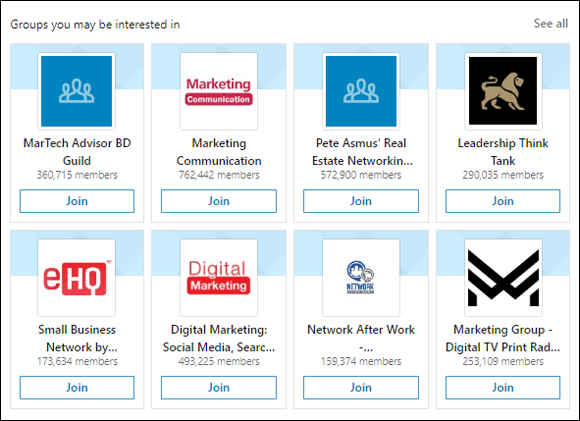
FIGURE 14-3: LinkedIn recommends groups you might be interested in.
Scroll through LinkedIn’s recommended groups, and if you see a group you would like to join, click the Join button.
Notice the total number of people in the group. The larger the number, the more your network expands when you join. Also, LinkedIn shows you the number of people you know within the group.
Searching for groups
Rather than just accepting groups that LinkedIn deems worthy of you, search for groups. LinkedIn has two types of groups: listed and unlisted. When searching for groups, you only see listed groups. Unlisted groups are unlisted and do not turn up in Search. The only way to join an unlisted group is to be invited to join.
Here’s how to search for listed groups that match your interests, goals, and target audience:
From any LinkedIn page, enter a group topic that would attract your target audience in the search bar at the top of the page.
Some keyword topic ideas include: Executives, Real Estate, B2B Marketing, CAD, CRM, Sales, Cloud Computing, Supply Chain, Retail, Fashion, Maritime, Military, and so on.
 When entering your keywords, LinkedIn offers numerous filters as you type. Choose from the suggested results (see Figure 14-4) and then skip to Step 5. If you don’t see anything that matches, click the Search button to be presented with a page of search results.
When entering your keywords, LinkedIn offers numerous filters as you type. Choose from the suggested results (see Figure 14-4) and then skip to Step 5. If you don’t see anything that matches, click the Search button to be presented with a page of search results.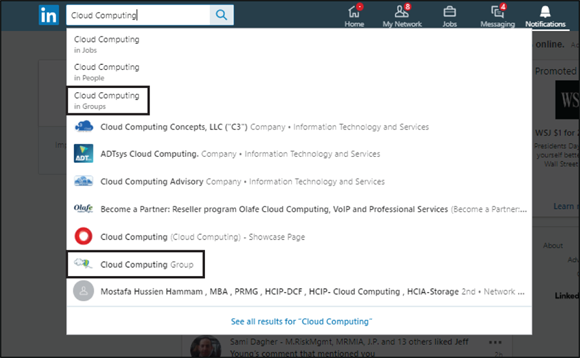
FIGURE 14-4: Choosing from the filtered drop-down list.
Click More to filter by groups at the top of the page
A list of groups displays, followed by the total number of members in the group and a short description, as shown in Figure 14-5.

FIGURE 14-5: Going through group search results.
If the group looks interesting, click the hyperlinked name of the group to visit the group overview page.
The group overview page shows you the admins of the group and who within your connections are members. If you wish to join, click the Ask to Join button; otherwise click your browser’s back button to go to the previous screen of search results.
- If you decide to join the group, click the Join button to immediately become a member, or if the group’s membership is moderated, click Request to Join.
Deleting groups
Now that you understand the strategy behind LinkedIn Groups, you may want to delete some groups that aren’t providing the value you need. Here’s how to delete groups you have already joined:
From any LinkedIn page, click the waffle (More or Work) icon located in the menu bar at the top of the screen and click Groups.
The list of groups you belong to appears. If you manage any groups, they appear at the top of the list.
- Scroll through the list until you find the group you want to remove.
- Click the three dots that appear to the right of each group listing and select Leave This Group, as shown in Figure 14-6.

FIGURE 14-6: Leaving a LinkedIn Group.
Turning off group communication email
You’ve joined 100 groups and suddenly you are beginning to see more views to your LinkedIn profile. As wonderful as that is, you are also seeing your email inbox fill up with LinkedIn Group update emails. It’s easy to turn off the LinkedIn Group communication email. Here’s how:
- Go to
LinkedIn.com. Click the thumbnail image of yourself that appears in the upper-right corner of your screen and click Settings & Privacy in the drop-down menu.
LinkedIn's settings page opens.
- Along the top of the settings page, click the Communications tab.
Under Notifications by Channel, click Email (received via your primary email).
The Email settings page opens. This is where you choose what email notifications you want to receive from LinkedIn.
Scroll down and click “Network: Groups, events, anniversaries, invites, birthdays.”
This is where you can toggle on or off email updates.
Click Group Daily Digests to see options for all the groups you belong to.
You can choose between Weekly digest, Daily digest, off, Individually, or Recommended, as shown in Figure 14-7.
 While you are on this screen, you may want to scroll down and see if there are any other email notifications you want to turn off. LinkedIn gives you control over how little or much it notifies you by email.
While you are on this screen, you may want to scroll down and see if there are any other email notifications you want to turn off. LinkedIn gives you control over how little or much it notifies you by email.
Choosing which groups to highlight on your profile
Your profile displays group logos on your profile with the option to expand to show the complete list. Although LinkedIn lists the groups on your profile randomly, you can determine whether to exclude a group from appearing.
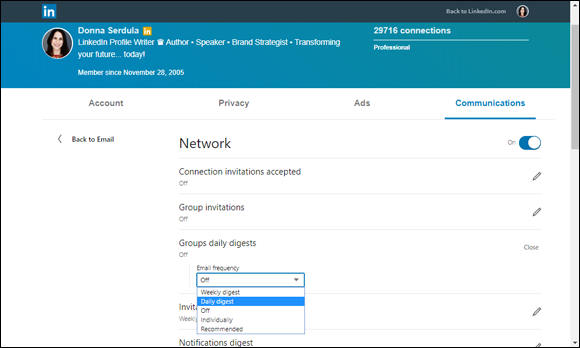
FIGURE 14-7: Stopping all those group emails from deluging your inbox.
Instead of leaving it to LinkedIn to showcase your group membership, it’s important you take control and determine the best groups to populate your profile to impress your target audience. Remember, it’s a Google world, and people are looking you up. They want to learn more about you. You control how they perceive you. As a reader scrolls through your profile, you want to make sure that the groups you are associated with build your brand and impress others.
In the section, “Determining the types of groups to join,” I suggest adding a few groups that showcase your industry knowledge. These groups are great to add to the top of your profile. Always think of your target audience. What group memberships might impress them? Which might make them feel confident in you?
Once you have an idea of the groups to spotlight on your profile, here’s how to display the logo on your profile:
From any LinkedIn page, click the waffle (More or Work) icon located in the menu bar at the top of the screen and click Groups.
The list of groups you belong to appears.
- To hide groups on your profile, click the three dots that appear to the right of the group name of the group you want to hide, as shown in Figure 14-8.
- Click Update Your Settings.
Toggle the “Display group on profile” option from Yes to No.
Now, the group’s logo will not appear on your profile.
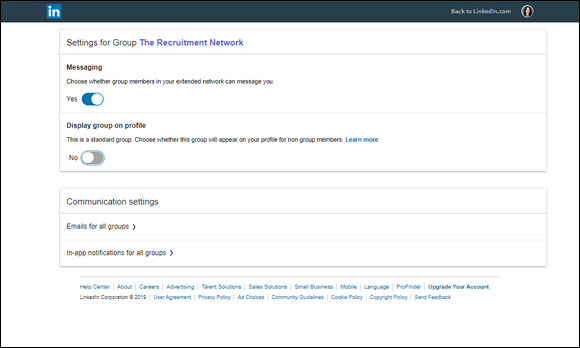
FIGURE 14-8: Changing the visibility of group logos on your profile.
Cultivating Your Following Section
When you first log in to LinkedIn, you land on the LinkedIn home page, which is where you write posts that are potentially seen by your network of connections. It’s also where you read your network’s posts. Think of this LinkedIn feed as your own customized newspaper, curated by all of your direct, first-degree LinkedIn connections. You are not limited to just status updates from first-degree connections, however. You can also subscribe to news topics of interest to you, company and school updates, and original content from Influencers. To tap into this stream of information, all you have to do is follow companies, news topics, Influencers, and schools that interest you.
By following companies, Influencers, and schools, you get their posts delivered to your LinkedIn feed. You show your interest and allegiance to them on your LinkedIn profile in the Following section, which appears at the very bottom of your profile. Within this section, logos of the Influencers, companies, groups, and schools you follow are displayed. To populate this section, you must join groups and follow some companies, Influencers, and schools; otherwise the Following section does not appear on your profile, and the opportunity to showcase potential commonality is lost.
You can follow as many as 1,000 companies and an unlimited number of Influencers and schools.
Choosing the right companies to follow
Just as individuals have LinkedIn profiles, companies have LinkedIn pages. A LinkedIn page is where a company tells its story, mission, and goals on LinkedIn and posts open positions. When employees and past employees list the company in their LinkedIn profiles’ experience sections, the logo that is displayed on their profiles comes from this LinkedIn page. A link is also created from the employees’ profiles to the LinkedIn page.
In addition to providing a digital outpost for the company on LinkedIn, the LinkedIn page provides the ability to post status updates as the company rather than as an individual. When you visit a LinkedIn page, you have the ability to follow that page and receive the updates it posts. Some LinkedIn pages have showcase pages. Most companies post statuses on a large variety of topics, but not all followers want to read such a wide range of topics. Showcase pages are for the different topics a LinkedIn page might broadcast. Visitors can then subscribe to the showcase page of the topic they are most interested in reading. When you subscribe to a showcase page, that logo is displayed on your profile as a company.
Curious about how to create a LinkedIn page for your company? Flip over to Chapter 11.
Not sure what companies to follow? No worries; here are some ideas to get you started:
- Your current company
- The companies where you worked in the past
- Your dream company(ies)
- Companies that are current or prospective customers
- Companies in the news
- Companies that are leaders within your industry or customers’ industries
- The companies where your friends and family members work
Following companies
It’s easy to follow companies on LinkedIn. Here’s how:
From any LinkedIn page, click in the search bar and start typing the name of a company you’d like to follow.
As you type, LinkedIn recommends matching LinkedIn pages.
If the page you are searching for appears, click it to open the LinkedIn page.
If LinkedIn doesn’t recommend the correct LinkedIn page, click the search button to display the search results.
Scroll through the results and click the LinkedIn page you’d like to follow.
The LinkedIn page opens.
Click the Follow button.
The button text changes to Following and the company appears in the Following section on your profile.
Unfollowing companies
If you go overboard and follow more companies than you are able to keep up with, or if you’ve changed your mind about showing allegiance to a certain company, simply stop following a company and its updates.
To unfollow a company, follow these steps:
- Go to your LinkedIn profile.
Scroll to the bottom of your profile to the Interests section and click See All.
The list of companies you follow appears. You may need to click the Companies tab at the top of the page.
Click the Following link next to the company you wish to unfollow.
Once clicked, you no longer follow that company and it is removed from your profile’s Interests section and you will no longer receive its broadcasted status updates.
Showcasing Influencers on Your Profile
Not only does LinkedIn provide curated content from around the web, you can also tap into original content by big-name thought leaders. These Influencers share their knowledge and insights through original articles found exclusively on LinkedIn. When you follow Influencers, you receive their latest articles via your LinkedIn home page’s newsfeed. Not only do you get to read their latest missives, but also you get to show your admiration and interest in them on your profile.
When people check out another person’s LinkedIn profile, they often scroll to the bottom to check out whether they have any Influencers in common. Seeing an admired thought leader on another person’s profile shows more than just a common interest; it shows a common philosophy and thought pattern. By following certain Influencers, you raise your reputation and viewpoint.
Deciding which Influencers to showcase
Unlike with groups, you cannot control the which Influencers are displayed on your profile. Just because you adore a certain Influencer, consider if that person is a polarizing individual, especially within your industry. Rather than choosing Influencers you truly love and want to follow, you may decide to choose Influencers who showcase you as you want to be seen.
If you want to be seen as a conservative, traditional leader, you may decide to follow Jack Welch rather than Mark Cuban. Although LinkedIn includes a number of politicians as Influencers, you may decide not to follow them and alienate half your audience. Or you may choose to show your allegiance and side with half your audience. The choice is yours and there really isn’t a right or wrong answer. Just know the repercussions of your choices.
LinkedIn doesn’t provide a list of Influencers. Rather than have you blindly search for Influencers, I’ve compiled a list of the most popular and prolific (see Table 14-1). See if any strike a chord with you. If they influence you, go ahead and follow them.
TABLE 14-1 List of Interesting Influencers
Adam Grant | Author and organizational psychologist at Wharton | B2B/Leadership | |
Beth Comstock | Author and former vice chair of GE | B2B/Leadership | |
Bill Gates | Co-chair, Bill & Melinda Gates Foundation | B2B/Leadership | |
Brené Brown | Research professor, CEO, and author | B2B/Leadership | |
Gary Vaynerchuk | Chairman, VaynerX and CEO, VaynerMedia | Marketing | |
Gretchen Rubin | Writer, podcaster | Human Resources | |
Jeff Weiner | Prior CEO of LinkedIn | B2B/Leadership | |
Jill Schlesinger | Business analyst, CBS News | B2B/Leadership | |
Josh Bersin | Principal and Founder, Bersin by Deloitte | Human Resources | |
Laszlo Bock | SVP, People Operations at Google and author of Work Rules! | Human Resources | |
Lou Adler | CEO, Adler Group and author of The Essential Guide For Hiring and Being Hired | Job Search | |
Marla Gottschalk | Director of Organizational Development, Allied Talent | Human Resources | |
Meg Whitman | CEO of Hewlett-Packard | B2B/Leadership | |
Melinda Gates | Co-chair, Bill & Melinda Gates Foundation | B2B/Leadership | |
Richard Branson | Founder, Virgin Group | B2B/Leadership | |
Ryan Holmes | CEO at Hootsuite | Marketing | |
Sallie Krawcheck | CEO and Co-Founder of Ellevest | B2B/Leadership | |
Simon Sinek | Author | B2B/Leadership |
Finding specific Influencers
Not all big names are Influencers. Although you can follow pretty much anyone, only Influencers you follow show up at the bottom of your LinkedIn profile under the Interests section. Check to see if a person you admire is an Influencer by following these steps:
From any LinkedIn page, enter the person’s name in the search bar at the top of the page.
As you type, LinkedIn presents you with name matches.
- If the person’s name appears, click it to open his or her profile.
If the person’s name doesn’t appear, click the search button and review the search results, clicking the person’s name to open his or her profile.
If the person is an Influencer, in the top-left corner of the profile, there is the Official LinkedIn Influencer badge that looks like a speech bubble that says “In.” Although you can connect with Influencers, the Follow button is highlighted, as shown in Figure 14-9.
You may see 1st, 2nd, or 3rd next to the person’s name, meaning that not only is the person an Influencer, but also you are connected to that person and that person is in your LinkedIn network.
- Click the Follow button to subscribe to the person’s long-form posts and status updates.

FIGURE 14-9: Connecting with an Influencer.
Discovering recommended Influencers
LinkedIn provides you with a partial list of recommended Influencers. Here’s how to access that list and follow those Influencers LinkedIn recommends for you:
- From any LinkedIn page, click My Network in the top toolbar.
Click People I Follow from the left sidebar.
If you already follow any Influencers, a list of those Influencers you follow appears.
Click the “Follow Fresh Perspectives” link at the top of the page.
A list of recommended Influencers appears, as shown in Figure 14-10. You can also navigate directly to the Fresh Perspectives page (
www.linkedin.com/feed/follow).This list is a combination of official Influencers and people that LinkedIn believes you should follow. Not everyone you follow will appear in your Interests section. You will also see hashtags and companies that LinkedIn believes may interest you.
Hover your mouse pointer over an Influencer that interests you and click Follow.
The plus ( + ) sign becomes a gray check mark, showing that you are following that Influencer.
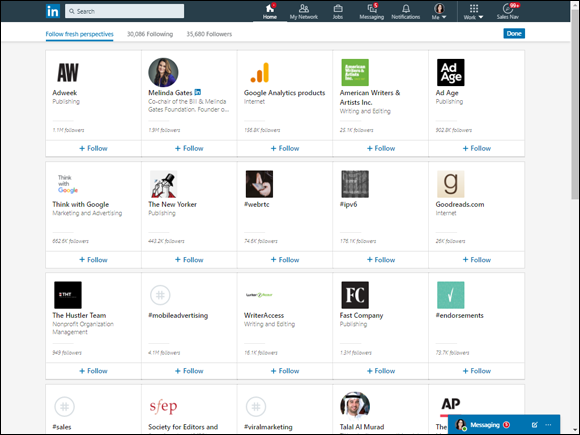
FIGURE 14-10: Following Influencers is as easy as clicking a plus ( + ) sign.
Removing Influencers
It’s a good idea to audit and edit your list of Influencers every few months. Not only does LinkedIn add Influencers, but also some Influencers you follow may lose their luster, and it’s best to remove them. Remember, nothing on LinkedIn is written in stone. Not only are you developing as a professional within your career, so are your interests and future vision of yourself. Make sure that you are always keeping your profile updated as to who you are right now in time.
Here’s how to remove Influencers from your profile:
- Go to your LinkedIn profile.
Scroll down to the Interests section and click See More.
A list of Influencers you are following appears. You may need to click the Influencers tab at the top.
Click the Following button to the right of the Influencer.
Once you click, that Influencer is removed from the Following section of your profile. You will no longer receive their status updates or long-form posts on your newsfeed.
Following Schools
When you click See More in the Interests section, you see the person’s list of Influencers, Companies, Groups, and Schools. I’ve shown you how to follow Influencers and companies in this chapter. I’ve also taught you to join groups strategically. Now it’s time to follow some schools to round out your Interests section.
What schools do you want to follow? Here are some ideas:
- The schools you attended
- The school you would love to attend
- Schools your college-bound child(ren) want to attend
- The school your spouse is attending or attended
- Schools that are your clients/prospects
- Schools that specialize in your field of expertise
- Schools that provide continuing education that you are interested in learning more about
Now that you have a list of schools in mind, here’s how you follow the school so that it shows up at the bottom of your LinkedIn profile’s Interests section:
From any LinkedIn page, enter the school’s name in the search bar at the top of the page.
As you type, LinkedIn presents you with name matches.
- If the school name appears, click it to open its LinkedIn page.
If the school doesn’t appear, click the Search button.
To filter for just schools, click More and then choose Schools.
- Review the search results, click the school to open its LinkedIn page.
- Click the Follow button to subscribe and have the school show up in your Interests list.
Once you follow the school you attended, don’t stop there! Click the Alumni section of the page to see some really great information. You can search for alumni between certain dates as well as search for alumni by job title, keyword, or company.
This is great if you are applying for a position at a certain company and you want more information or maybe even an introduction. Check out the alumni section to see if you went to school with anyone who works there! Talk about commonality! If you scroll even further down, you can see more information about where alumni work and love. Scrolling down further you can see a list of all alumni.
Your Interests section is now fully optimized, you are also following some really interesting people, groups, and learning institutions making your LinkedIn feed a little more interesting than before. You have also reached the end of your LinkedIn profile.
How do you feel? That insurmountable task is now behind you! Although your profile is optimized, there’s still a little more to do. In the next chapter, I show you how to join the LinkedIn conversation through posts and articles. Meet you there!
